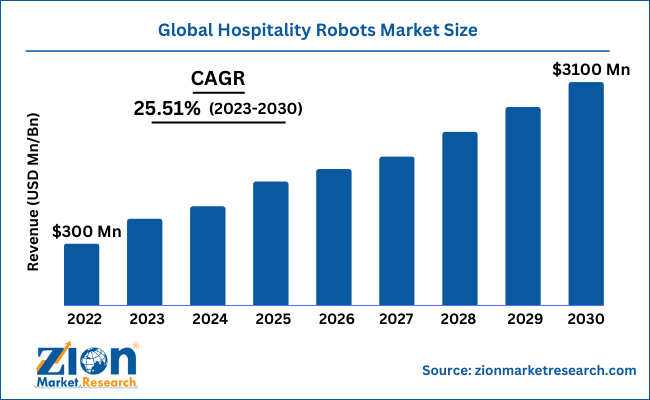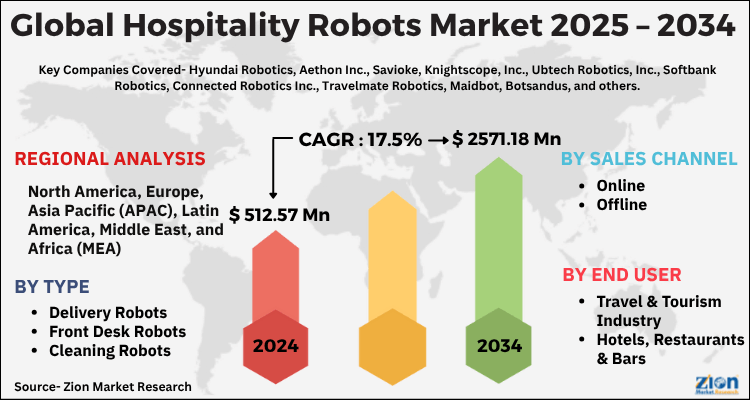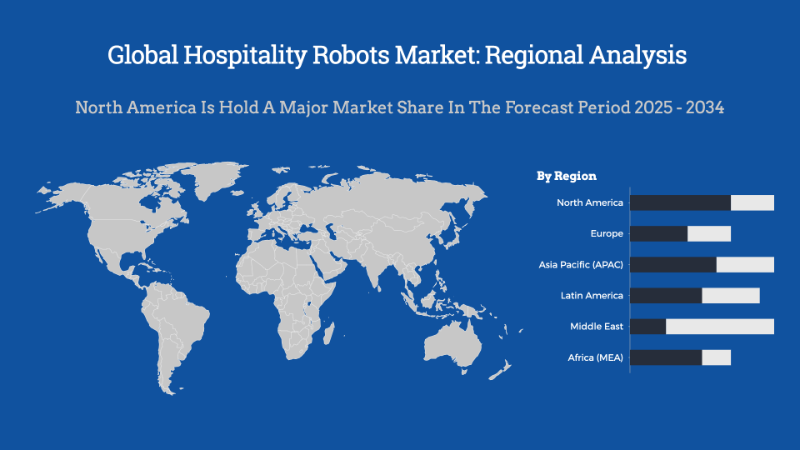Global Hospitality Robots Market Size, Share, Growth Analysis Report - Forecast 2034

Hospitality Robots Market By Type (Front Desk Robots, Delivery Robots, Cleaning Robots, Others), By End user (Hotels, Restaurants and Bars, Travel and Tourism Industry), By sales channel (Online, Offline), and By Region: Global and Regional Industry Overview, Market Intelligence, Comprehensive Analysis, Historical Data, and Forecasts 2025 - 2034
| Market Size in 2024 | Market Forecast in 2034 | CAGR (in %) | Base Year |
|---|---|---|---|
| USD 512.57 Million | USD 2571.18 Million | 17.5% | 2024 |
Global Hospitality Robots Market: Industry Perspective
The global hospitality robots market size was worth around USD 512.57 Million in 2024 and is predicted to grow to around USD 2571.18 Million by 2034 with a compound annual growth rate (CAGR) of roughly 17.5% between 2025 and 2034. The report analyzes the global hospitality robots market's drivers, restraints/challenges, and the effect they have on the demands during the projection period. In addition, the report explores emerging opportunities in the hospitality robots industry.
The report analyzes the global hospitality robots market drivers, restraints/challenges, and the effect they have on the demands during the projection period. In addition, the report explores emerging opportunities in the hospitality robots industry.
Global Hospitality Robots Market: Overview
Hospitality robots are semi-autonomous or autonomous robots that are gaining high popularity in the hospitality industry. They can be used for a wide variety of tasks that would otherwise be done by a human. Some of these tasks include serving food & drinks, welcoming guests, cleaning rooms, and providing room service, assisting with luggage. As the demand and investments for complete automation across sectors are on the rise, the hospitality robots industry can expect higher revenue during the forecast period. There are different types of robots that are specifically designed to cater to the needs of the hospitality industry including cleaning robots, humanoid robots, service robots, and others. There are several factors that are expected to work in the favor of the industry but it may also have to deal with severe challenges and roadblocks. Some of the key players that are currently leading the industry growth are SoftBank Robotics, Savioke, Inc., Panasonic Corporation, LG Electronics, Inc., and Knightscope, Inc.
Global Hospitality Robots Market: Growth Drivers
Growing need for higher productivity and efficiency to propel market demand
The global hospitality robots market is projected to grow owing to the increasing demand for higher productivity and efficiency in the hospitality segment. As hotel companies and other hospitality service providers are under intense competition from new and emerging business players in the sector, they are investing in technology and systems that allow them to provide improved customer experience as it is the only way companies can manage to survive in this hospitality industry. Associated services and their quality are crucial to these businesses since meeting customer expectations is important for revenue.
This is a major reason why hotel and restaurant owners are adopting robots so that they can improve efficiency and productivity. Robots are capable of performing duties like cleaning rooms and providing customer service so that the human staff can be employed for other serious and non-mundane tasks. Furthermore, the growing demand for personalized and customized experiences when they travel could lead to more robot employment.
Restraints:
Limited functionality to restrict hospitality robots market growth
Although hospitality robots are efficient in their designated tasks since they run on technological components, the current-age robots are limited in terms of functional outputs. For instance, robots lack the necessary intellectual or emotional skills that humans possess in the face of sudden or unexpected events. Since robots are programmed to perform specific tasks, it will be difficult for them to provide the same quality of assistance while handling complex customer service issues.
Opportunities:
Growing integration with other technologies to provide growth opportunities
Since the global hospitality robots industry holds high potential, it is witnessing a surge in investment rate as robot-making companies work toward the development of more capable and sophisticated robots. This can be achieved by integrating advanced technologies like artificial intelligence (AI) and machine learning (ML) along with others to improve the performance efficiency of the robots and make them capable of handling more difficult or unpredictable situations. Furthermore, the market is yet to completely explore the potential of emerging economies.
Challenges:
Resistance from human labor to act as a major challenge
Although it comes with excellent benefits, automation has always been a threat to human labor since automated mechanisms can perform the duty of a hundred employees in a shorter time. The human resources working in the hospitality sector may presume that the robots could lead to employment threats since owners may prefer to utilize the benefits of robots. Hence it is crucial for hospitality robots industry players to ensure that a balanced system is maintained in which all stakeholders can benefit.
Key Insights
- As per the analysis shared by our research analyst, the global hospitality robots market is estimated to grow annually at a CAGR of around 17.5% over the forecast period (2025-2034).
- Regarding revenue, the global hospitality robots market size was valued at around USD 512.57 Million in 2024 and is projected to reach USD 2571.18 Million by 2034.
- The hospitality robots market is projected to grow at a significant rate due to rising labor costs, demand for contactless services, advancements in AI and robotics, and increasing adoption in hotels and restaurants.
- Based on Type, the Front Desk Robots segment is expected to lead the global market.
- On the basis of End user, the Hotels segment is growing at a high rate and will continue to dominate the global market.
- Based on the sales channel, the Online segment is projected to swipe the largest market share.
- Based on region, North America is predicted to dominate the global market during the forecast period.
Global Hospitality Robots Market: Report Scope
| Report Attributes | Report Details |
|---|---|
| Report Name | Hospitality Robots Market |
| Market Size in 2024 | USD 512.57 Million |
| Market Forecast in 2034 | USD 2571.18 Million |
| Growth Rate | CAGR of 17.5% |
| Number of Pages | 212 |
| Key Companies Covered | Hyundai Robotics, Aethon Inc., Savioke, Knightscope, Inc., Ubtech Robotics, Inc., Softbank Robotics, Connected Robotics Inc., Travelmate Robotics, Maidbot, Botsandus, and others. |
| Segments Covered | By Type, By End user, By sales channel, and By Region |
| Regions Covered | North America, Europe, Asia Pacific (APAC), Latin America, The Middle East and Africa (MEA) |
| Base Year | 2024 |
| Historical Year | 2020 to 2023 |
| Forecast Year | 2025 - 2034 |
| Customization Scope | Avail customized purchase options to meet your exact research needs. Request For Customization |
Global Hospitality Robots Market: Segmentation
All the segments have been analyzed based on present and future trends and the market is estimated from 2025 to 2034.The global hospitality robots market is segmented based on type, sales channel, end-user, and region.
Based on type, the global market segments are delivery robots, front desk robots, cleaning robots, and others. In 2024, the industry registered the highest growth in the delivery robots segment. They are used in the hospitality segment to deliver food, drinks, and other items to the guests in their rooms or other areas within the vicinity of the hotel. These robots are programmed to navigate through various common obstacles that exist in a hotel setting to ensure the smooth delivery of the product. The cleaning robots are programmed to clean or sanitize common areas, guest rooms, and other spaces in the hotel. Delivery robots typically cost between $10,000 to $30,000 USD.
Based on sales channel, the global hospitality robots market is segmented into online and offline.
Based on end-user, the global market divisions are travel & tourism industry, and hotel, restaurants & bars. The industry is expected to witness the highest CAGR in the hotel, restaurant, and bars segment during the forecast period. This segment includes units like bars, hotels, resorts, motels, restaurants, cafes, and other food and beverage establishments. The business utilizes pre-programmed robots to automate several manual and everyday tasks like delivering items to guests, cleaning, and providing customer service. The travel and tourism industry uses hospitality robots to improve guest experience but is nonetheless a small market as compared to the latter type. In 2024, the HoReCa (hotels, restaurants, and catering) industry was over USD 4 trillion.
The Regional, this segment includes the current and forecast demand for North America, Europe, Asia Pacific, Latin America,and the Middle East and Africa.
Recent Developments:
- In February 2024, Bear Robotics, Inc., a US-based player in the market, announced the launch of Servi which, as per the company definition, is an innovative new robot that intends to revolutionize the food & service sector. The company is targeting care home and hospitality businesses to make use of AI-driven robots for mundane tasks like clearing tables and serving food & drinks
- In March 2024, Bear Robotics announced another addition to its offerings with the launch of Servi Plus which boasts enhanced user experience features when compared to its predecessor. Some of the added features are an expanded 40 Kg payload and a capacity of more than 16 dishes
- In July 2024, Super Eagle Technology announced the launch of the company’s AI robot server called IPAW Model L which is being regarded as a game-changing robot for the hospitality sector
Global Hospitality Robots Market: Regional Analysis
The Hospitality Robots Market is experiencing varied regional growth driven by technological adoption, labor shortages, and evolving consumer expectations. North America leads the market due to early adoption of automation and high investments in AI and robotics across hotels and restaurants. Asia-Pacific is witnessing rapid expansion, particularly in countries like Japan, China, and South Korea, where cultural acceptance of robotics and innovation in service industries are accelerating growth. Europe is also emerging as a strong market, supported by smart hotel initiatives, rising tourism, and increasing focus on contactless guest experiences. Meanwhile, regions in the Middle East and Latin America are gradually adopting hospitality robots, especially in luxury and high-end establishments seeking to differentiate services and improve operational efficiency.
Global Hospitality Robots Market: Competitive Analysis
The report provides a company market share analysis to give a broader overview of the key market players. In addition, the report also covers key strategic developments of the market, including acquisitions & mergers, new product launches, agreements, partnerships, collaborations & joint ventures, research & development, and regional expansion of major participants involved in the hospitality robots market on a global and regional basis.
The global hospitality robots market is dominated by players like:
- Hyundai Robotics
- Aethon Inc.
- Savioke
- Knightscope Inc.
- Ubtech Robotics Inc.
- Softbank Robotics
- Connected Robotics Inc.
- Travelmate Robotics
- Maidbot
- Botsandus
Global Hospitality Robots Market: Segmentation Analysis
The global hospitality robots market is segmented as follows;
By Type
- Delivery Robots
- Front Desk Robots
- Cleaning Robots
- Others
By Sales Channel
- Online
- Offline
By End-User
- Travel & Tourism Industry
- Hotels, Restaurants & Bars
Global Hospitality Robots Market: Regional Segment Analysis
- North America
- The U.S.
- Canada
- Europe
- France
- The UK
- Spain
- Germany
- Italy
- Rest of Europe
- Asia Pacific
- China
- Japan
- India
- South Korea
- Southeast Asia
- Rest of Asia Pacific
- Latin America
- Brazil
- Mexico
- Rest of Latin America
- Middle East & Africa
- GCC
- South Africa
- Rest of Middle East & Africa
Table Of Content
Methodology
FrequentlyAsked Questions
Hospitality robots are semi-autonomous or autonomous robots that are gaining high popularity in the hospitality industry. They can be used for a wide variety of tasks that would otherwise be done by a human. Some of these tasks include serving food & drinks, welcoming guests, cleaning rooms, and providing room service, assisting with luggage. As the demand and investments for complete automation across sectors are on the rise, the hospitality robots industry can expect higher revenue during the forecast period. There are different types of robots that are specifically designed to cater to the needs of the hospitality industry including cleaning robots, humanoid robots, service robots, and others.
The global hospitality robots market is expected to grow due to increasing labor shortages, demand for automation to enhance operational efficiency, advancements in AI and robotics technologies, and the need to improve customer service and satisfaction.
According to a study, the global hospitality robots market size was worth around USD 512.57 Million in 2024 and is expected to reach USD 2571.18 Million by 2034.
The global hospitality robots market is expected to grow at a CAGR of 17.5% during the forecast period.
North America is expected to dominate the hospitality robots market over the forecast period.
Leading players in the global hospitality robots market include Hyundai Robotics, Aethon Inc., Savioke, Knightscope, Inc., Ubtech Robotics, Inc., Softbank Robotics, Connected Robotics Inc., Travelmate Robotics, Maidbot, Botsandus, among others.
The report explores crucial aspects of the hospitality robots market, including a detailed discussion of existing growth factors and restraints, while also examining future growth opportunities and challenges that impact the market.
HappyClients
Zion Market Research
Tel: +1 (302) 444-0166
USA/Canada Toll Free No.+1 (855) 465-4651
3rd Floor,
Mrunal Paradise, Opp Maharaja Hotel,
Pimple Gurav, Pune 411061,
Maharashtra, India
Phone No +91 7768 006 007, +91 7768 006 008
US OFFICE NO +1 (302) 444-0166
US/CAN TOLL FREE +1 (855) 465-4651
Email: sales@zionmarketresearch.com
We have secured system to process your transaction.
Our support available to help you 24 hours a day, five days a week.
Monday - Friday: 9AM - 6PM
Saturday - Sunday: Closed







